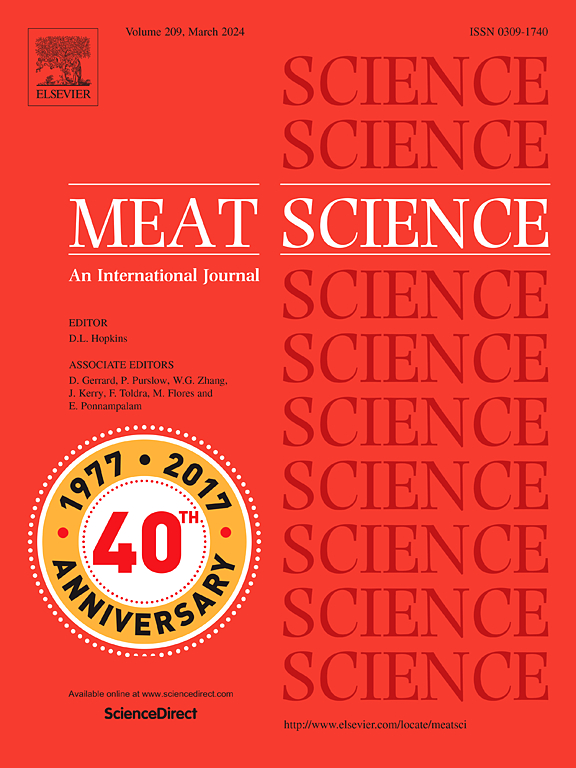Use of almond hulls in lamb diets – Effects on growth performance and carcass and meat quality
IF 7.1
1区 农林科学
Q1 Agricultural and Biological Sciences
引用次数: 0
Abstract
The effect of partial replacement of cereals by increasing levels of almond hulls (AH) was tested in twenty-four lambs distributed into three dietary treatments: 1) diet without replacement of cereals with AH (0AH); 2) diet with replacement of cereals with 9% of AH (9AH); and 3) diet with replacement of cereals with 18% of AH (18AH). All diets included 40% dehydrated lucerne and 5% soybean oil. Dry matter intake, growth performance, feed costs, carcass traits, meat quality, and lipid oxidative stability of raw and cooked meat during refrigerated storage were evaluated. Replacing part of the cereal with AH up to 18% did not affect the average daily gain but increased quadratically the feed conversion ratio and tended to decrease linearly the slaughter live weight. Diet cost per kg live weight gain was affected quadratically, with similar feed costs in 0AH and 18AH diets. The carcass and meat quality parameters were not affected by diet, except meat shear force that linearly reduced with the inclusion of AH in diets, meat flavour acceptability that showed lower values in 9AH diet, and lipid stability. Lipid oxidation increased in raw and cooked meat during storage, but the 18AH diet resulted in lower lipid oxidation in cooked meat than the other diets. Replacing part of the cereal with AH up to 18% in diets composed of 40% forage shown to be a dietary strategy applicable to fattening lamb, allowing high productive performances without relevant impact on feed costs, and improving lipid stability of cooked meat.
在羔羊日粮中使用杏仁壳。对生长性能、胴体和肉品质的影响。
通过提高杏仁壳(AH)水平部分替代谷物的效果,对24只羔羊进行了试验,羔羊被分为3个饲粮处理:1)不使用AH替代谷物(0AH);2)以9%的AH (9AH)替代谷物;3)饮食中用18%的AH (18AH)代替谷物。所有日粮包括40%脱水苜蓿素和5%大豆油。研究了冷藏期间生肉和熟肉的干物质采食量、生长性能、饲料成本、胴体性状、肉品质和脂质氧化稳定性。在部分谷物中添加高达18%的碱对平均日增重没有影响,但饲料系数呈二次增长,屠宰活重呈线性下降趋势。每公斤活增重的饲粮成本受到二次影响,0AH和18AH饲粮的饲料成本相似。除肉剪切力随饲粮中添加AH而线性降低外,胴体和肉品质参数均不受饲粮的影响,肉味可接受度在饲粮中降低,脂质稳定性也降低。在贮藏过程中,生肉和熟肉的脂质氧化增加,但18AH日粮导致熟肉的脂质氧化低于其他日粮。在由40%饲料组成的日粮中,用高达18%的ahp替代部分谷物是一种适用于育肥羔羊的日粮策略,可以在不影响饲料成本的情况下提高生产性能,并改善熟肉的脂质稳定性。
本文章由计算机程序翻译,如有差异,请以英文原文为准。
求助全文
约1分钟内获得全文
求助全文
来源期刊

Meat Science
工程技术-食品科技
CiteScore
12.60
自引率
9.90%
发文量
282
审稿时长
60 days
期刊介绍:
The aim of Meat Science is to serve as a suitable platform for the dissemination of interdisciplinary and international knowledge on all factors influencing the properties of meat. While the journal primarily focuses on the flesh of mammals, contributions related to poultry will be considered if they enhance the overall understanding of the relationship between muscle nature and meat quality post mortem. Additionally, papers on large birds (e.g., emus, ostriches) as well as wild-captured mammals and crocodiles will be welcomed.
 求助内容:
求助内容: 应助结果提醒方式:
应助结果提醒方式:


